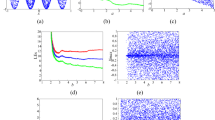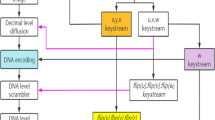Abstract
In order to improve the efficiency and security of image compression-encryption algorithms, we propose a double image compression-encryption scheme based on fractional hyper-chaotic system and DNA approach. Firstly, two images are processed by discrete cosine transform. Secondly, the spectrums of the two images are sorted by Z-scan, so that the two images can be compressed and mixed into a new image. Finally, the resulting image is encrypted by using DNA coding. Different from traditional image encryption algorithms, the proposed algorithm provides a variety of DNA coding and operation modes. Chaotic sequences are used to control the coding and operation mode in order to improve the complexity of the encryption process. Fractional order and initial values of fractional order hyper-chaotic system are used as the key of the proposed algorithm, which greatly expands the complexity and the key space of the scheme. In the proposed scheme, by mixing two images and performing a compression-encryption operation on them simultaneously, the proposed algorithm can improve the complexity of encrypted images while providing good confusion. Experimental results and security analysis show that the proposed algorithm can effectively resist multiple attacks.








Similar content being viewed by others
References
“Data Encryption Standard” (1977) Federal Information Processing Standards Publication (FIPS PUB) No. 46, National Bureau of Standards, Washington, DC
Alfalou A, Brosseau C (2010) Exploiting root-mean-square time-frequency structure for multiple-image optical compression and encryption. Opt Lett 35(11):1914–1916
Baptista MS (1998) Cryptography with chaos. Phys Lett A 240(1–2):50–54
Bose R, Pathak S (2006) A novel compression and encryption scheme using variable model arithmetic coding and coupled chaotic system. IEEE Trans Circuits Syst I Reg Papers 53(4):848–857
Chai X, Gan Z, Chen Y, Zhang Y (2017) A visually secure image encryption scheme based on compressive sensing. Signal Process 134:35–51
Chai XL, Fu XL, Gan ZH, Lu Y, Chen YR (2019) A color image cryptosystem based on dynamic DNA encryption and chaos. Signal Process 155(1):44–62
Chai X, Wu H, Gan Z, Zhang Y, Chen Y, Nixon KW (2020) An efficient visually meaningful image compression and encryption scheme based on compressive sensing and dynamic LSB embedding. Opt Lasers Eng 124:105837
Chai X, Wu H, Gan Z, Zhang Y, Chen Y (2020) Hiding cipher-images generated by 2-D compressive sensing with a multi-embedding strategy. Signal Process 171:107525
Chen GR, Ueta T (1999) Yet another chaotic attractor. Int J Bifurc Chaos 9:1465–1466
Chen TH, Wu CS (2010) Compression-unimpaired batch-image encryption combining vector quantization and index compression. Inf Sci 180(9):1690–1701
Chen JX, Zhang Y, Qi L (2018) Exploiting chaos-based compressed sensing and cryptographic algorithm for image encryption and compression. Opt Laser Technol 99(2):238–248
Deng J, Zhao S, Wang Y, Wang L, Wang H, Sha H (2017) Image compression-encryption scheme combining 2D compressive sensing with discrete fractional random transform. Multimed Tools Appl 76(7):10097–10117
Donoho DL (2006) Compressed sensing. IEEE Trans Inf Theory 52(4):1289–1306
Dube S, Sharma K (2019) Hybrid approach to enhance contrast of image for forensic investigation using segmented histogram. Int J Adv Intell Paradigms 13(1–2):43–66
Gong LH, Deng CZ, Pan SM (2018) Image compression-encryption algorithms by combining hyper-chaotic system with discrete fractional random transform. Opt Laser Technol 103(1):48–58
Grangetto M, Magli E, Olmo G (2006) Multimedia selective encryption by means of randomized arithmetic coding. IEEE Trans Multimedia 8(5):905–917
Hermassi H, Rhouma R, Belghith S (2010) Joint compression and encryption using chaotically mutated Huffman trees. Commun Nonlinear Sci Numer Simul 15(10):2987–2999
Huffman DA (2006) A method for the construction of minimum-redundancy codes. Resonance 11(2):91–99
Jakimoski G, Subbalakshmi KP (2008) Cryptanalysis of some multimedia encryption schemes. IEEE Trans Multimedia 10(3):330–338
Kayalvizhi S, Malarvizhi S (2020) A novel encrypted compressive sensing of images based on fractional order hyper chaotic Chen system and DNA operations. Multimed Tools Appl 79(5–6):3957–3974
Kim H, Wen JT, Villasenor J (2007) Secure arithmetic coding. IEEE Trans Signal Process 55(5):2263–2272
Landir M, Hamiche H, Kassim S (2019) A novel robust compression-encryption of images based on SPIHT coding and fractional-order discrete-time chaotic system. Opt Laser Technol 109(1):534–546
Langdon GG, Rissanen JJ (1979) Arithmetic coding. IBM J Res 23(2):149–162
Li PY, Lo KT (2018) A content-adaptive joint image compression and encryption scheme. IEEE Trans Multimed 20(8):1960–1972
Liu X, Cao Y, Lu P, Lu X, Li Y (2013) Optical image encryption technique based on compressed sensing and Arnold transformation. Optik 124(24):6590–6593
Lv XP, Liao XF, Yang B (2018) A novel scheme for simultaneous image compression and encryption based on wavelet packet transform and multi-chaotic systems. Multimed Tools Appl 77(21):28633–28663
Nagaraj N, Vaidya PG, Bhat K (2009) Arithmetic coding as a non-linear dynamical system. Commun Nonlinear Sci Numer Simul 14(4):1013–1020
National Institute of Standards and Technology (2001) Advanced encryption standard (AES)
Ponuma R, Amutha R (2018) Compressive sensing based image compression-encryption using novel 1D-Chaotic map. Multimed Tools Appl 77(15):19209–19234
Sharma K, Bala S, Bansal H, Shrivastava G (2017) Introduction to the special issue on secure solutions for network in scalable computing. Scalable Comput Pract Exp 18(3):3–5
Shrivastava G, Pandey A, Sharma K (2013) Steganography and Its Technique: Technical Overview. Proceedings of the Third International Conference on Trends in Information, Telecommunication and Computing. Springer, New York
Shrivastava G, Nhu NG, Bouhlel MS, Sharma K (2017) Special issue on advance research in model driven security, privacy, and forensic of smart devices preface
Shrivastava G, Kumar P, Gupta BB (2018) Handbook of research on network forensics and analysis techniques[M]
Wang QZ, Wei MY, Chen XM (2018) Joint encryption and compression of 3D images based on tensor compressive sensing with non-autonomous 3D chaotic system. Multimed Tools Appl 77(2):1715–1734
Watson JD, Crick FHC (1953) A structure for deoxyribose nucleic acid. Nature 171(4356):737–738
Wen JT, Kim H, Villasenor J (2006) Binary arithmetic coding with key-based interval splitting. IEEE Signal Process Lett 13(2):69–72
Yang YG, Guan BW, Li J, Li D, Zhou YH, Shi WM (2019) Image compression-encryption scheme based on fractional order hyper-chaotic systems combined with 2D compressed sensing and DNA encoding. Opt Laser Technol 119:105661
Zhang YS, Xiao D, Liu H, Nan H (2014) GLS coding based security solution to JPEG with the structure of aggregated compression and encryption. Commun Nonlinear Sci Numer Simul 19(5):1366–1374
Zhou J, Au OC (2008) Comments on “a novel compression and encryption scheme using variable model arithmetic coding and coupled chaotic system”. IEEE Trans Circuits Syst I Reg Papers 55(10):3368–2269
Zhou J, Liang Z, Chen Y (2007) Security analysis of multimedia encryption schemes based on multiple Huffman table. IEEE Signal Process Lett 14(3):201–204
Zhou J, Au OC, Wong PH (2009) Adaptive chosen-ciphertext attack on secure arithmetic coding. IEEE Trans Signal Process 57(5):1825–1838
Zhou N, Li H, Wang D, Pan S, Zhou Z (2015) Image compression and encryption scheme based on 2D compressive sensing and fractional Mellin transform. Opt Commun 343:10–21
Zhou NR, Pan SM, Cheng S, Zhou ZH (2018) Image compression encryption scheme based on hyper-chaotic system and 2D compressive sensing. Opt Laser Technol 82(3):121–133
Zhu HG, Zhao C, Zhang XD (2013) A novel image encryption-compression scheme using hyper-chaos and Chinese remainder theorem. Signal Process Image Commun 28(9):670–680
Acknowledgments
This work was supported by the Beijing Municipal Science & Technology Commission (Project No. Z191100007119004), the Beijing Natural Science Foundation (Grant No. 4182006), and the Guangxi Key Laboratory of Cryptography and Information Security (Grant No. GCIS201810).
Author information
Authors and Affiliations
Corresponding author
Additional information
Publisher’s note
Springer Nature remains neutral with regard to jurisdictional claims in published maps and institutional affiliations.
Rights and permissions
About this article
Cite this article
Yang, YG., Guan, BW., Zhou, YH. et al. Double image compression-encryption algorithm based on fractional order hyper chaotic system and DNA approach. Multimed Tools Appl 80, 691–710 (2021). https://doi.org/10.1007/s11042-020-09779-5
Received:
Revised:
Accepted:
Published:
Issue Date:
DOI: https://doi.org/10.1007/s11042-020-09779-5




